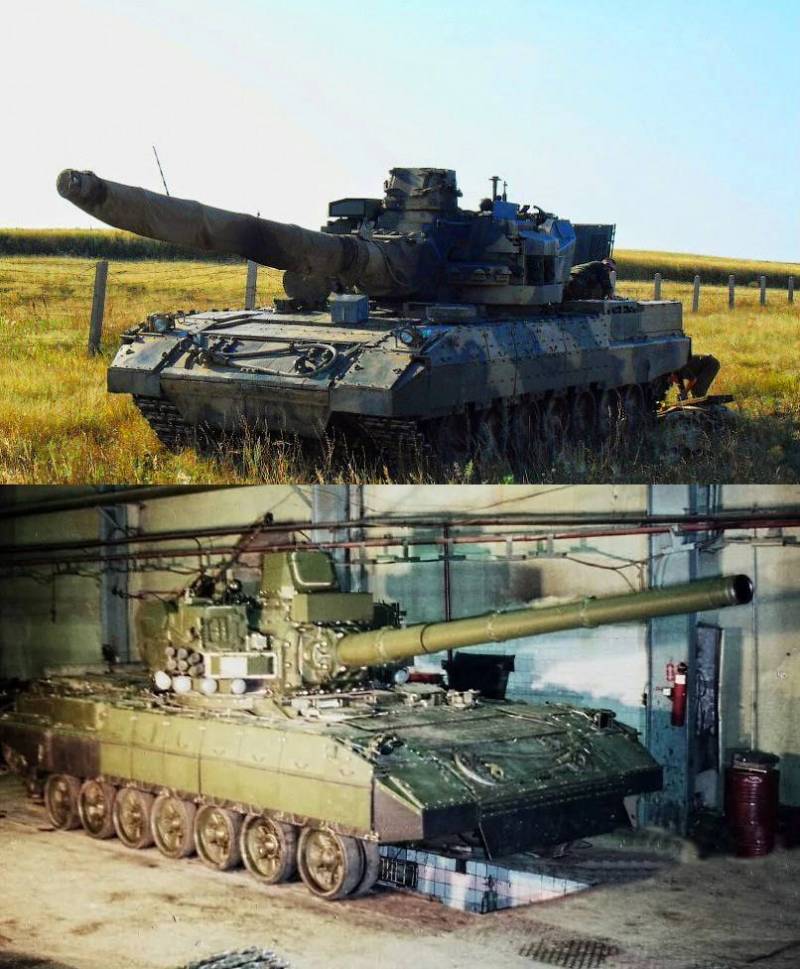Can the SVO give a second chance to the T-95 and Black Eagle tanks
A few weeks ago, the Russian media reported that Black Eagle tanks equipped with 152 mm caliber guns would allegedly be sent to the NVO zone to hunt Leopards. However, this information did not receive confirmation, proving, apparently, not a very smart April Fool's joke. But what could be changed on the battlefield by promising armored vehicles that were not put into production for the sake of Armata?
As you know, there are two directions in tank building - with diesel and gas turbine engines, which have their own advantages and disadvantages. Only two countries in the world, the US and Russia, have technology serial production of gas turbine power plants for tanks, which provide heavy armored vehicles with high speed and dynamics, the ability to quickly start up in harsh climatic conditions such as the Arctic, but at the same time they are very capricious in operation somewhere in the desert. The Americans have the Abrams, while we have the T-80 and T-80U family of tanks.
"Black Eagle" / "Object 640"
What is special about Black Eagle? This is a modernized version of the T-80U, which was supposed to surpass the Abrams, Leclerc, Leopard-2 and Challenger-2 in terms of its performance characteristics. From its predecessor, the "Object 640" inherited an improved undercarriage, which would simplify its mass production. The hull is lengthened, the turret is noticeably enlarged, and its armor has been improved. In the stowed position, the gunner and tank commander are located in the hull and in the turret, and in the combat seat of the crew they are transferred below the level of the turret shoulder strap. With a mass of only 48 tons, the Black Eagle was equipped with a gas turbine power plant with a capacity of 1500 liters. with., which increased its specific power to the level of 30 liters. With. / t., significantly better than Western competitors of the 3rd generation.
What interests us most is the armament of the tank. "Object 640" was to be equipped with a 125-mm cannon, a 7,62-mm machine gun coaxial with it and a remote anti-aircraft gun with a 12,7-mm Kord machine gun. However, according to a number of sources, it was structurally possible to install a larger-caliber gun - from 135 mm to 152 mm. In other words, this would turn the Black Eagle into a real "killer of Leopards and other Abrams."
In the realities of the NMD in Ukraine, a tank carrying such a large-caliber gun could demolish entire buildings turned by the enemy into defensive fortifications with a few shots. A big plus of this project would be the actual transition of Russian artillery to 152 mm caliber shells due to the emerging "shell hunger" in the 122 mm segment.
Unfortunately, the promising tank, developed in the "dashing nineties" by the Omsk Design Bureau of Transport Engineering, was not useful to the country and did not go into production. It was promised that the developments on the Black Eagle would be used in the Armata platform.
T-95/"Object 195"
Another unrealized promising project of domestic tank building can be considered "Object 195", which was worked on by JSC "Scientific and Production Corporation "Uralvagonzavod" named after F. E. Dzerzhinsky" from 1999 to 2010. It was preceded by the Soviet Improvement-88 program, which involved changing the layout of the armored vehicle in order to reduce visibility and improve crew safety. To do this, the gun had to be placed in a small uninhabited tower, and the crew, reduced to two people, in a special armored capsule, separated from it and from the automatic loading mechanism. The weight of a Soviet tank with a noticeably reduced silhouette on the battlefield was to be 55 tons.

These ideas were embodied in the "Object 195". During its development, the so-called carriage layout was used. The armament of the T-95 was a 152 mm 2A83 gun with a new automatic loader, an auxiliary 30 mm 2A42 automatic cannon and a 12,7 mm Kord machine gun in a remote-controlled turret. The fire control system was supposed to be equipped with a thermal imager, a laser rangefinder and a radar, as well as a "friend or foe" recognition system. The engine was supposed to have a power of 1500 to 1650 liters. With. depending on modification. The crew of the T-95 would have been only two people, sheltered in an armored capsule in the bow.
Unfortunately, the "Object 195", like the "Object 640", did not go into the series, since it was recognized as "morally obsolete". Instead, the rate of the Ministry of Defense of the Russian Federation was made on the more promising platform "Armata". What do we have in the bottom line as of the second half of April 2023?
There are a couple of dozens of T-14 "Armata", which so far are not really used in the assaults of Ukrainian fortified areas. There are hundreds of really good T-90M "Proryv" tanks suitable for serial production, which are our main hope for a breakthrough in the NWO. In reality, all the hardships of a large-scale armed conflict are being pulled by the age-old T-72s of various modifications, as well as the old T-62Ms being modernized and sent to the front, and the very ancient T-55s. This conflict, alas, is likely to last for a long time, so why not really think about giving tanks with a 152 mm gun a second chance? There will be more than enough work ahead of them.

Information